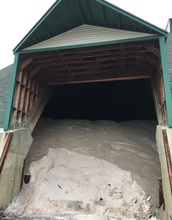
Our water supplies are suffering from a severe salt “cocktail” hangover.
During winter months, it’s easy to reach for the rock salt to melt the ice and snow on walkways and driveways for safety sake. Across North America, streams and rivers are becoming saltier, thanks to road deicers, fertilizers and other salty compounds that humans indirectly release into waterways. At the same time, freshwater supplies are becoming more alkaline or basic, the “opposite” of acidic. This is due to a combination of types of salts, researchers have dubbed “cocktails.”
This means big problems for drinking water supplies, urban infrastructure and natural ecosystems. The well-documented water crisis in Flint, Michigan, for example, occurred when the city switched its primary water source to the Flint River in 2014; the river’s high salt load combined with chemical treatments made the water corrosive and caused lead to leach from water pipes.
The National Science Foundation (NSF) funded the first research to assess long-term changes in freshwater salinity and pH — a measure of how acidic or alkaline something is — at the continental scale.
“Such water quality issues as sewage, wastewater and nutrient loading are being addressed,” said Tom Torgersen, director of NSF’s Water Sustainability and Climate program, which funded the research. “But management of water quality impacts remains a challenge because of our increasing population, the size of our built infrastructure and other factors.”
A half-century of data
The analysis draws from 50 years worth of data recorded at 232 monitoring sites across the country and shows significant increases in both salinization and alkalization. The results also suggest a close link between the two properties, with different salt compounds combining to do more damage than any one salt could do on its own.
“This research demonstrates the value of long-term data in identifying potential threats to valuable freshwater resources,” said John Schade, an NSF Long-Term Ecological Research program director. “Without such long-term efforts, widespread and significant degradation of water quality by human activities would remain unknown. Now we can begin to unravel the causes and develop strategies to mitigate potential effects on the environment and public health.”
The analysis, which is published in this week’s issue of the journal Proceedings of the National Academy of Sciences, has implications for freshwater management and salt regulation strategies in the United States, Canada and beyond. Researchers at the University of Maryland (UMD), the Cary Institute of Ecosystem Studies, the University of Connecticut (UConn), the University of Virginia and Chatham University co-authored the study.
“We created the term ‘Freshwater Salinization Syndrome’ because we realized that it’s a suite of effects on water quality,” said Sujay Kaushal, a biogeochemist at UMD and lead author of the study. “Many people assume that when you apply salt to roads and other surfaces it just gets washed away and disappears. But salt accumulates in soils and groundwater and takes decades to get flushed out.”
Changes in rivers across the country
The researchers documented sharp chemical changes in many of the country’s major rivers, including the Mississippi, Hudson, Potomac, Neuse, Canadian and Chattahoochee rivers. Many of these rivers supply drinking water for nearby cities and towns, including some of the most densely populated urban centers along the Eastern Seaboard. Kaushal said most freshwater salinization research has focused on sodium chloride, better known as table salt, which is also the dominant chemical in road deicers.
Salt has a much broader definition, encompassing any combination of positively and negatively charged ions that dissociate in water. Some of the most common positive ions found in salts — including sodium, calcium, magnesium and potassium — can have damaging effects on freshwater at higher concentrations.
“These ‘cocktails’ of salts can be more toxic than just one salt, as some ions can displace and release other ions from soils and rocks, compounding the problem,” said Kaushal. “Ecotoxicologists are just beginning to understand this.”
The study is the first to simultaneously account for multiple salt ions in freshwater across the United States and southern Canada. The results suggest that salt ions, damaging in their own right, are driving up the alkalinity of freshwater as well.
Significant increase in salinity
Over the 50-year study, the researchers concluded 37 percent of the drainage area in the contiguous United States experienced a significant increase in salinity. Alkalization, which is influenced by a number of different factors in addition to salinity, increased by 90 percent.
“Our study is the first to document a link between increased salinization and alkalization at the continental scale,” said scientist and study co-author Gene Likens of the Cary Institute of Ecosystem Studies and UConn. “Until now, we didn’t fully appreciate the role that different salts play in altering the pH of streams and rivers of our country. Salt content and pH are fundamental aspects of water chemistry, so these are major changes to the properties of freshwater.”
The causes for increased salt in waterways vary from region to region, Kaushal said. In the snowy Mid-Atlantic and New England, road salt applied to maintain roadways in winter is a primary culprit. In the heavily agricultural Midwest, fertilizers, particularly those with high potassium content, also make major contributions. In other regions, mining waste and weathering of concrete, rocks and soils releases salts into adjacent waterways.
“We found that the pH of some rivers started increasing in the 1950s and ’60s — decades before the implementation of acid rain regulations,” said Michael Pace, an environmental scientist at the University of Virginia and a co-author of the study. “We also observed increased salt concentrations in the Southeast, where they don’t apply road salts. These surprising trends presented a puzzle that our team worked to solve.”
In the drought stricken desert Southwest, where salt concentrations are historically high, Kaushal and his colleagues documented an overall decrease in salinity over time. The researchers attribute the decrease to a variety of factors, including changes in land and water use, coupled with an effort on the part of Western state and local governments to reduce salt use and improve water resource management strategies. For example, in 1973, the seven Western states included in the Colorado River Basin created the Colorado River Basin Salinity Control Forum to support salinity control efforts.
New salt pollution management strategies needed
Kaushal said many strategies for managing salt pollution already exist. Evidence suggests that brines are more efficient than granulated salt for deicing roads, yielding the same effect with less overall salt input. Pre- salting before a major snow event can also improve results.
“Not all salts are created equal in terms of their ability to melt ice at certain temperatures,” Kaushal added. “Choosing the right salt compounds for the right conditions can help melt snow and ice more efficiently with less salt input, which would go a long way toward solving the problem.”
Kaushal also said many Mid-Atlantic and Northeastern cities and states use outdated and inefficient salt-spreading equipment which are overdue for an upgrade. Fertilizer application in agricultural settings needs an upgrade as well. Applying correct fertilizer amounts at the right time in the season help reduce the overall output of salts into nearby streams and rivers. Careful urban development strategies, primarily building farther from waterways and designing better storm water drainage systems, can help reduce the amount of salt washed away from weathered concrete, the scientists say. There’s also a need to replace aging water pipes throughout the country, those affected by corrosion and scaling, or the buildup of mineral deposits and microbial films. Such pipes are particularly vulnerable to saltier, more alkaline water, increasing the release of toxic metals and other contaminants.
“The trends we are seeing show that we need to consider the issue of salt pollution and take it seriously,” Kaushal said. “These factors are something we need to address to provide safe water now and for future generations.”
—
The National Science Foundation (NSF) is an independent federal agency that supports fundamental research and education across all fields of science and engineering. In fiscal year (FY) 2017, its budget is $7.5 billion. NSF funds reach all 50 states through grants to nearly 2,000 colleges, universities and other institutions. Each year, NSF receives more than 48,000 competitive proposals for funding and makes about 12,000 new funding awards.

No comments yet.